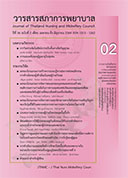Healthcare Problems and Healthcare Service Accessibility for Children with Craniofacial Anomalies: Caregivers’ Perceptions
Keywords:
healthcare problems, health services accessibility, congenital craniofacial anomaliesAbstract
Objective: To explore caregivers’ perceptions regarding healthcare and healthcare service accessibility problems faced by children with craniofacial anomalies Design: Descriptive research
Methodology: The primary participants, recruited using convenience sampling and inclusion/exclusion criteria, were 121 primary caregivers of children with non-cleft craniofacial anomalies treated at a super-tertiary hospital in Bangkok. Data from the primary participants were collected via three questionnaires, on personal information, child care problem perceptions, and access to health services. The secondary participants were 13 purposively sampled caregivers, who supplied additional data via focus group discussions. The data were collected between October 2018 and September 2019 and analysed using descriptive statistics and content analysis.
Results: More than four-fifths (80.20%) of the caregivers had a low degree of overall perception of children’s healthcare problems, whereas about three-fourths (75.20%) displayed a high degree of overall perception of children’s access to healthcare services. The qualitative data revealed three major aspects of child healthcare problems, namely, (1) caring difficulty, variety of problems, and frequent hospital visits; (2) mental problems and demand for social
understanding and acceptance; and (3) high care and travel expenses. Regarding access to child healthcare services, two issues were identified. First, information on the hospital’s and physician’s specialisation played an important part in decision-making. Second, the healthcare team’s perspective and network could affect the method of treatment.
Recommendations: Healthcare team members are advised to assist children with congenital craniofacial anomalies who are faced with severe and complex health problems to have better and quicker access to healthcare services through referrals to super-tertiary hospitals for appropriate treatment during the first year of life.
Downloads
References
Crockett, DJ, Goudy, SL. Cleft lip and palate. Facial Plast Surg Clin North Am 2014; 22: 573-86.
Goyal M, Chopra R, Bansal K, Marwaha M. Role of obturators and other feeding interventions in patients with cleft lip and palate: a review. Eur Arch Paediatr Dent 2014;15:1-9.
I-Tuporn N, Ratanasiri A, Nutravong T, Boonprasert K, Chatrchaiwiwatana S, Na Pikul T. Prevalence rate of congenital craniofacial deformities in Chiang Rai Prachanukroh Hospital, Chiang Rai Province. Srinagarind Medical Journal 2019: 169-72. (In Thai)
Kluba S, Rohleder S, Wolff M, Haas-Lude K, Schuhmann MU, Will BE, et al. Parental perception of treatment and medical care in children with
craniosynostosis. Int J Oral Maxillofac Surg 2016;1-6.
Nguyen TB, Shock LA, Missoi TG, Muzaffar AR. Incidence of amblyopia and its risk factors in children with isolated metopic craniosynostosis. Cleft Palate Craniofac J 2016;53(1):e14-7.
Rojavachiranonda N. Craniosynostosis [Internet]. 2019. [cited 2020 Oct 21] Available from:, http://www.craniofacial.or.th/kn_craniosynostosis.php
Crerant CE, Sarwer DB, Kazak AE, Clarke A, Psych D, Rumsey N. Body image and quality of life in adoescents with craniofacial conditions. Cleft Palate Craniofac J 2017;54(1):2-12.
Dangsomboon A. Jirapaet V. Experiences of caregivers having children with craniosynostosis using distractor devices. J Health Res 2017;31(2):119-26.
Ratanarojsakul P. Learning and creating of knowledge of community and family of disabled children. Journal of Education 2015;16(2):15-27. (In Thai)
Imnamkhao W, Imnamkhao S, Suriyo S, Jaisuer D. Quality of life’s caregiever and person of disabilities at tumbon Wangsang Mahasarakham province. Journal of Nurses’ Association of Thailand, North- Eastern Division 2013;31(1):72-79. (In Thai)
Taub PJ, Lampert JA. Pediatric craniofacial surgery: a review for the multidisciplinary team. Cleft Palate Craniofac J 2011;48(6):670-83.
Suthanurak S. Prevalence of cleft lip and/or palate in Phatthalung province. Reg 11 Med J 2015;29(4): 587-595. (In Thai)
Rongbudsri S, Patjanasoontorn N, Pradabwong S, Chowchuen B. Development outcomes of Thai children with cleft lip/palate at 5-years-old. Journal of The Medical Association of Thailand 2012;95 (Suppl.
:S88-92. (In Thai)
Mongkhonthawornchai S, Pradabwong S, Augsornwan D, Pongpagatip S, Rirattanapong S, Prathumwiwattana P, et al. Nursing care system development for patients with cleft lip-palate and craniofacial deformities at Srinagarind hospital. Journal of The Medical Association of
Thailand 2012; 95(Suppl. 11):S49-54. (In Thai)
Yamane T. Statistics: an introductory analysis. 3rd ed. New York: Harper and Row Publications; 1973. 16. Penchansky R, Thomas JW. The concept of access definition and relationship to consumer satisfaction. Med Care 1981;19 (2): 127-40.
Wongrattana C. Techniques in using statistics for research. 13th ed. Bangkok: Amorn Printing; 2017. (In Thai)
Holloway I, Wheeler S. Qualitative research for nursing. Oxford: Blackwell Science; 1996.
Lincoln YS, Guba EG. Naturalistic inquiry. Newbury Park, CA: SAGE; 1985.
Duggleby W, Williams A, Ghosh S, Moquin H, Ploeg J, Markle-Reid M, et al. Factors influencing changes in heath related quality of life of caregivers of persons with multiple chronic conditions. Health Qual Life Outcomes 2016; 14 (81): 1–9. doi.org/10. 1186/s12955-016-0486-7.
Whiting M. Support requirements of parents caring for a child with disability and complex health needs. Nurs Child Young People 2014; 26(4): 24-7.
AI-Dababneh KA, Fayez M, Bataineh O. Needs of parents caring for children with physical disabilities: a case study in Jordan. Int J Spec Educ 2012; 27(3): 120-33.
Cassell CH, Strassle P, Mendez DD, Lee KA, Krohmer A, Meyer RE, et al. Barriers to care for children with orofacial clefts in North Carolina. Birth Defects Res A Clin Mol Teratol 2014; 100 (11): 837-47.
doi.10.1002/bdra.23173.
Carmona R, Jones TA, Rosenberg J. Barriers to accessing medical care for Hispanic individuals with craniofacial conditions. Plast Surg Nurs 2020;
(2):73-80.doi: 10.1097/PSN.0000000000000302.








